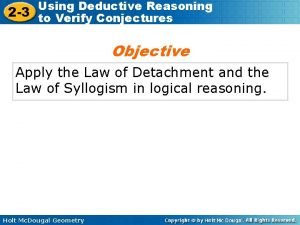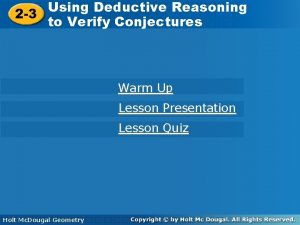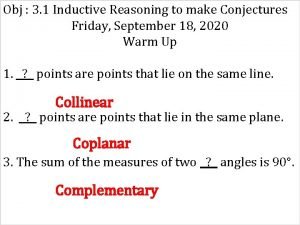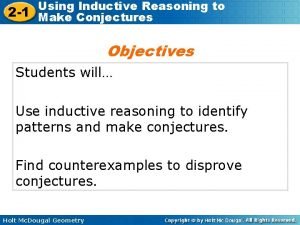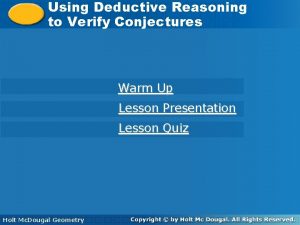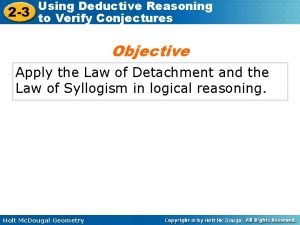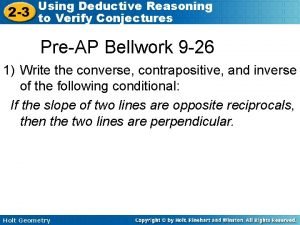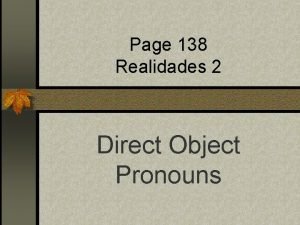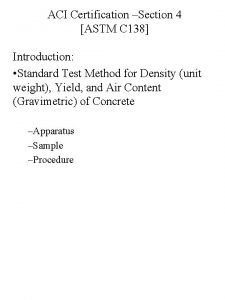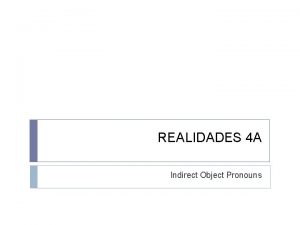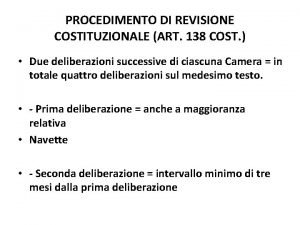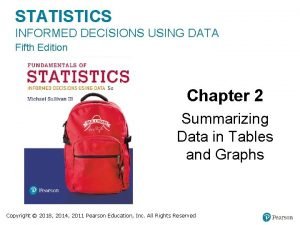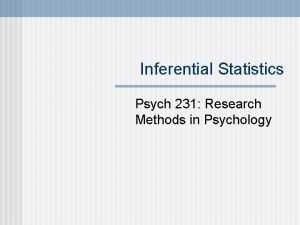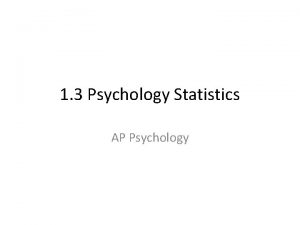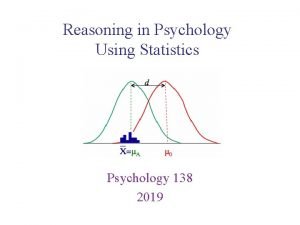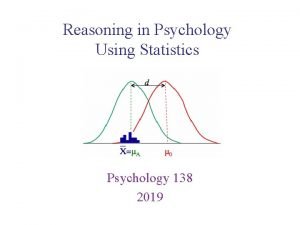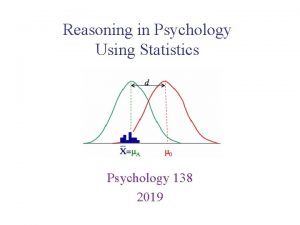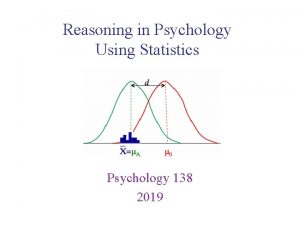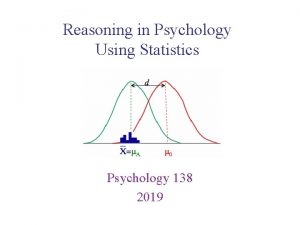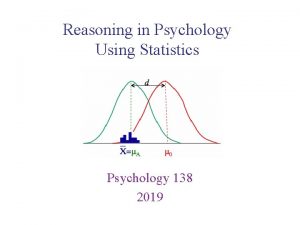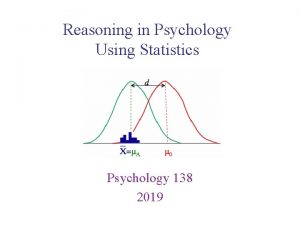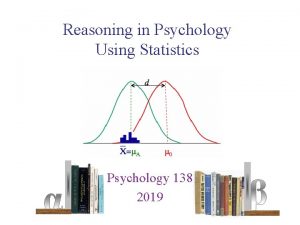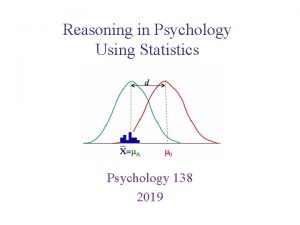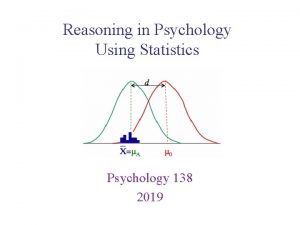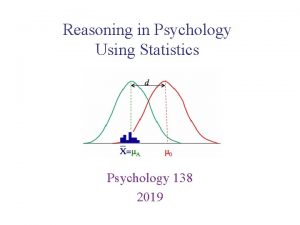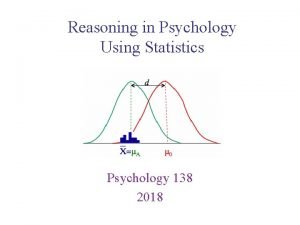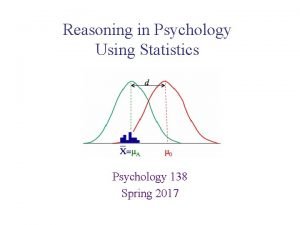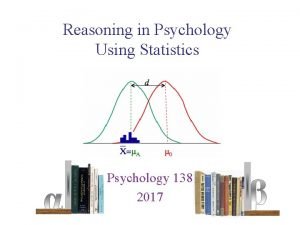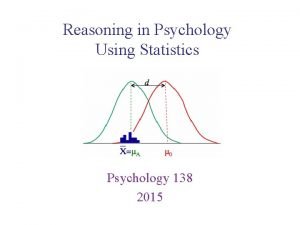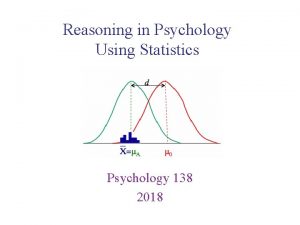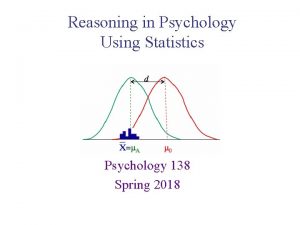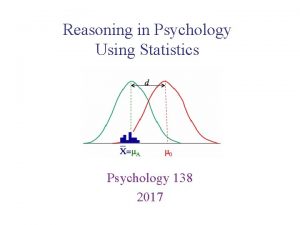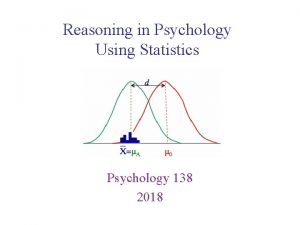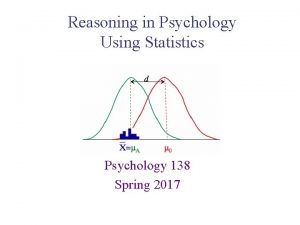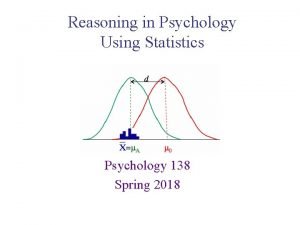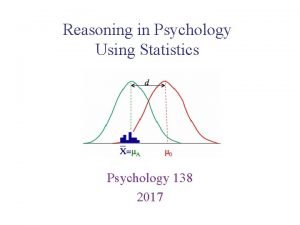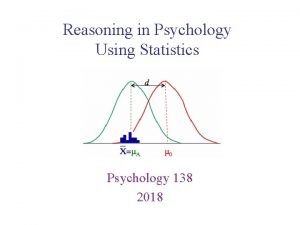Reasoning in Psychology Using Statistics Psychology 138 2019














































- Slides: 46

Reasoning in Psychology Using Statistics Psychology 138 2019

• Quiz 3 due Friday, Feb. 22 at 11: 59 pm – Covers • Tables and graphs • Measures of center • Measures of variability • You don’t need SPSS, but may want to have a calculator handy Announcements Reasoning in Psychology Using Statistics

• In addition to pictures of the distribution, numerical summaries are also typically presented. – Numeric Descriptive Statistics Today’s focus • Shape: skew and kurtosis • Measures of Center: mode, median, mean • Measures of Variability (Spread): Range, Inter-quartile range, Standard Deviation (& variance) Descriptive statistics Reasoning in Psychology Using Statistics

• Quantitative measure of how spread out or clustered scores are – the degree of “differentness” of the scores in the distribution. • High variability: scores differ a lot – SD = 8. 1 – 26 - 72 • Low variability: scores are all similar – SD = 5. 8 – 35 - 74 Variability of a distribution Reasoning in Psychology Using Statistics

• Simplest measure of variability – Range = Maximum - Minimum – Disadvantage: based solely on two most extreme values Range Reasoning in Psychology Using Statistics

• IQR: Alternative measure of variability – Middle 50% of scores Inter-Quartile Range Reasoning in Psychology Using Statistics Newly designed webpages

• IQR: Alternative measure of variability – Middle 50% of scores – Median (50%tile): 1/2 distribution on one side & 1/2 on other side. – 25%tile? – 75%tile? Median 25%tile 75%tile 25% Inter-Quartile Range Reasoning in Psychology Using Statistics 25%

• IQR: Alternative measure of variability – IQR = 3 rd quartile - 1 st quartile – Middle 50% of the scores Median 25%tile 75%tile 25% 25% IQR Inter-Quartile Range Reasoning in Psychology Using Statistics

• IQR: Alternative measure of variability – IQR = 3 rd quartile - 1 st quartile – Middle 50% of the scores – Works well for skewed distributions Inter-Quartile Range Reasoning in Psychology Using Statistics

• IQR: Alternative measure of variability - IQR more representative than Range - Extreme scores (i. e. , outliers) have less influence (robust) - Disadvantage: all scores not represented (only the middle 50%) IQR 25% 25% IQR Inter-Quartile Range Reasoning in Psychology Using Statistics 25%

• Most utilized & important measure of variability – Standard deviation measures how far off all of the scores are from a standard. • Computations for sample and population are (slightly) different – Standard deviation ~~ average of deviations* Typically mean is used as standard. μ Standard Deviation & Variance Reasoning in Psychology Using Statistics *Mean Absolute Differences vs. SD

• Step 1: For measure of deviation, subtract population mean from every score. Our population 2, 4, 6, 8 -3 1 2 3 4 5 6 7 8 9 10 X - μ = deviation scores μ 2 - 5 = -3 Computing standard deviation (population) Reasoning in Psychology Using Statistics

• Step 1: For measure of deviation, subtract population mean from every score. Our population 2, 4, 6, 8 -1 1 2 3 4 5 6 7 8 9 10 X - μ = deviation scores μ 2 - 5 = -3 4 - 5 = -1 Computing standard deviation (population) Reasoning in Psychology Using Statistics

• Step 1: For measure of deviation, subtract population mean from every score. Our population 2, 4, 6, 8 1 1 2 3 4 5 6 7 8 9 10 X - μ = deviation scores 2 - 5 = -3 4 - 5 = -1 μ 6 - 5 = +1 (balances off -1) Computing standard deviation (population) Reasoning in Psychology Using Statistics

• Step 1: For measure of deviation, subtract population mean from every score. Our population 2, 4, 6, 8 3 1 2 3 4 5 6 7 8 9 10 X - μ = deviation scores 2 - 5 = -3 4 - 5 = -1 μ 6 - 5 = +1 8 - 5 = +3 Computing standard deviation (population) Reasoning in Psychology Using Statistics

• Characteristic of average of deviation scores: Total of the deviations must equal 0 X - μ = deviation scores 2 - 5 = -3 6 - 5 = +1 4 - 5 = -1 8 - 5 = +3 -3 + -1 + 3 = -4 + 4 = 0 Mean is the balancing point, so 2 sides are equal, that is, total deviations on each side are equal 1 2 3 4 5 6 7 8 9 10 μ Good check of computations Computing standard deviation (population) Reasoning in Psychology Using Statistics

• Step 2: Preserve all deviations, positive & negative. How? – Square the deviations! SS = Σ (X – μ)2 – Add to get Sum of Squared deviations, MEMORIZE! “Sum of Squares” (SS) Note Order Of Operations! X - μ = deviation scores 2 - 5 = -3 4 - 5 = -1 6 - 5 = +1 8 - 5 = +3 SS = (-3)2 + (-1)2 + (+3)2 = 9 + 1 + 9 = 20 Computing standard deviation (population) Reasoning in Psychology Using Statistics

• Step 3: Compute Variance. – To get mean squared deviation, divide SS by number of scores Variance = σ2 = SS/N Our population So N = 4 2, 4, 6, 8 MEMORIZE! (Population) = 20/4 = 5. 0 Computing standard deviation (population) Reasoning in Psychology Using Statistics

• Step 4: Compute the Standard Deviation – Variance = average squared deviation score – Get average deviation score by taking square root of variance MEMORIZE! Standard Deviation = σ = (Population) Computing standard deviation (population) Reasoning in Psychology Using Statistics

• A good idea: check your answer, does it appear to be in the right ballpark? Our population 2, 4, 6, 8 +2. 24 -2. 24 1 2 3 4 5 6 7 8 9 10 X - μ = deviation scores 2 - 5 = -3 4 - 5 = -1 μ 6 - 5 = +1 8 - 5 = +3 Computing standard deviation (population) Reasoning in Psychology Using Statistics

• To review (computing standard deviation for a population): – – Step 1: compute deviation scores Step 2: compute SS Step 3: determine variance ( σ2 squared standard deviation) Step 4: determine standard deviation (square root of variance) Standard Deviation = σ Computing standard deviation (population) Reasoning in Psychology Using Statistics

• For a sample: The basic procedure is the same. – – Step 1: Step 2: Step 3: Step 4: compute deviation scores compute SS determine variance This step is different determine standard deviation Computing standard deviation (sample) Reasoning in Psychology Using Statistics

• Step 1: Compute deviation scores – subtract sample mean from every score Our sample 2, 4, 6, 8 Notational differences 1 2 3 4 5 6 7 8 9 10 X - X = deviation scores 2 - 5 = -3 4 - 5 = -1 6 - 5 = +1 8 - 5 = +3 X Numerically everything is the same as before Computing standard deviation (sample) Reasoning in Psychology Using Statistics

• Step 2: Compute Sum of Squared deviations (SS). X - X = deviation scores 2 - 5 = -3 4 - 5 = -1 6 - 5 = +1 8 - 5 = +3 SS = Σ (X - X)2 = (-3)2 + (-1)2 + (+3)2 = 9 + 1 + 9 = 20 Apart from notational differences, procedure same as before Computing standard deviation (sample) Reasoning in Psychology Using Statistics

• Step 3: Determine Variance Recall: Population variance = σ2 = SS/N Samples’ variability smaller than population’s X 4 X 1 μ X 3 X 2 Computing standard deviation (sample) Reasoning in Psychology Using Statistics

• Step 3: Determine Variance Recall: Population variance = σ2 = SS/N Samples’ variability smaller than population’s To estimate population variance (what we are interested in) from sample, correct by dividing by (n-1) instead of just n Sample variance = s 2 Notational differences Computing standard deviation (sample) Reasoning in Psychology Using Statistics

• Step 4: Determine the standard deviation Standard Deviation = s = (Sample) MEMORIZE! MOST IMPORTANT!! NOTE: SPSS, Excel, other spreadsheets, and calculators use this formula for standard deviation. Computing standard deviation (sample) Reasoning in Psychology Using Statistics

• Change/add/delete a given score, then the standard deviation will change. – May change the mean and (if adding or subtracting) the number of scores (n or N) Characteristics of a standard deviation Reasoning in Psychology Using Statistics

• Change/add/delete a given score, then the standard deviation will change. • Add/subtract a constant to each score, then the standard deviation will NOT change. – All of the scores change by the same constant. Xold Characteristics of a standard deviation Reasoning in Psychology Using Statistics

• Change/add/delete a given score, then the standard deviation will change. • Add/subtract a constant to each score, then the standard deviation will NOT change. – All of the scores change by the same constant. Xold Characteristics of a standard deviation Reasoning in Psychology Using Statistics

• Change/add/delete a given score, then the standard deviation will change. • Add/subtract a constant to each score, then the standard deviation will NOT change. – All of the scores change by the same constant. Xold Characteristics of a standard deviation Reasoning in Psychology Using Statistics

• Change/add/delete a given score, then the standard deviation will change. • Add/subtract a constant to each score, then the standard deviation will NOT change. – All of the scores change by the same constant. Xold Characteristics of a standard deviation Reasoning in Psychology Using Statistics

• Change/add/delete a given score, then the standard deviation will change. • Add/subtract a constant to each score, then the standard deviation will NOT change. – All of the scores change by the same constant. – But so does the mean Xnew Characteristics of a standard deviation Reasoning in Psychology Using Statistics

• Change/add/delete a given score, then the standard deviation will change. • Add/subtract a constant to each score, then the standard deviation will NOT change. – It is as if you just pick up the distribution and move it over, but the spread (variability) stays the same Xold Characteristics of a standard deviation Reasoning in Psychology Using Statistics

• Change/add/delete a given score, then the standard deviation will change. • Add/subtract a constant to each score, then the standard deviation will NOT change. – It is as if you just pick up the distribution and move it over, but the spread (variability) stays the same Xold Characteristics of a standard deviation Reasoning in Psychology Using Statistics

• Change/add/delete a given score, then the standard deviation will change. • Add/subtract a constant to each score, then the standard deviation will NOT change. – It is as if you just pick up the distribution and move it over, but the spread (variability) stays the same Xold Characteristics of a standard deviation Reasoning in Psychology Using Statistics

• Change/add/delete a given score, then the standard deviation will change. • Add/subtract a constant to each score, then the standard deviation will NOT change. – It is as if you just pick up the distribution and move it over, but the spread (variability) stays the same Xold Characteristics of a standard deviation Reasoning in Psychology Using Statistics

• Change/add/delete a given score, then the standard deviation will change. • Add/subtract a constant to each score, then the standard deviation will NOT change. – It is as if you just pick up the distribution and move it over, but the spread (variability) stays the same Xold Characteristics of a standard deviation Reasoning in Psychology Using Statistics

• Change/add/delete a given score, then the standard deviation will change. • Add/subtract a constant to each score, then the standard deviation will NOT change. – It is as if you just pick up the distribution and move it over, but the spread (variability) stays the same Xold Characteristics of a standard deviation Reasoning in Psychology Using Statistics

• Change/add/delete a given score, then the standard deviation will change. • Add/subtract a constant to each score, then the standard deviation will NOT change. – It is as if you just pick up the distribution and move it over, but the spread (variability) stays the same Xold Characteristics of a standard deviation Reasoning in Psychology Using Statistics

• Change/add/delete a given score, then the standard deviation will change. • Add/subtract a constant to each score, then the standard deviation will NOT change. – It is as if you just pick up the distribution and move it over, but the spread (variability) stays the same Xold Xnew Characteristics of a standard deviation Reasoning in Psychology Using Statistics

• Change/add/delete a given score, then the standard deviation will change. • Add/subtract a constant to each score, then the standard deviation will NOT change. – Looking at a numerical example. (subtract 1 from every score) Original sample Original mean 2, 4, 6, 8 5 New sample New mean 1, 3, 5, 7 4 2 - 5 = -3 6 - 5 = +1 Original SS 4 - 5 = -1 8 - 5 = +3 20 1 - 4 = -3 5 - 4 = +1 Original SS 3 - 4 = -1 7 - 4 = +3 20 Characteristics of a standard deviation Reasoning in Psychology Using Statistics

• Change/add/delete a given score, then the mean will change. • Add/subtract a constant to each score, then the standard deviation will NOT change. • Multiply (or divide) each score by a constant, then the standard deviation will change by being multiplied by that constant. 20 21 22 23 24 21 - 22 = -1 23 - 22 = +1 (-1)2 (+1)2 s= X Characteristics of a standard deviation Reasoning in Psychology Using Statistics

• Change/add/delete a given score, then the mean will change. • Add/subtract a constant to each score, then the standard deviation will NOT change. • Multiply (or divide) each score by a constant, then the standard deviation will change by being multiplied by that constant. 40 42 44 46 48 42 - 44 = -2 46 - 44 = +2 s= X (-2)2 (+2)2 Sold=1. 41 Characteristics of a standard deviation Reasoning in Psychology Using Statistics

• Extreme scores: Range is most affected, IQR is least affected • Sample size: Range tends to increase as n increases, IQR & SD do not • With open-ended distributions, one cannot even compute the Range or SD, so the IQR is the only option • Range is unstable when you repeatedly sample from the same population, but the IQR & SD are stable and tend not to fluctuate. When to use which Reasoning in Psychology Using Statistics

• Today’s lab: compute several measures of variability both by hand using SPSS • Questions? • • • Variability Defined: part 1 (~4 mins) | part 2 (~7 mins) Jbstatistics: Measures of Variability (~12 mins) Kahn. Academy: Why divide by n-1? (~10 mins) Brief Tutorial on Statistics: Measures of Variability (~17 mins) SPSS Range, IQR, Standard Deviation (~3 mins) Wrap up Reasoning in Psychology Using Statistics
 Inductive method
Inductive method Example of a deductive argument
Example of a deductive argument Inductive reasoning vs deductive reasoning
Inductive reasoning vs deductive reasoning Inductive reasoning vs deductive reasoning
Inductive reasoning vs deductive reasoning Inductive vs deductive geometry
Inductive vs deductive geometry Inductive reasoning is reasoning based on patterns
Inductive reasoning is reasoning based on patterns Deductive rrasoning
Deductive rrasoning Introduction to statistics what is statistics
Introduction to statistics what is statistics Deductive
Deductive Using inductive reasoning to make conjectures answers
Using inductive reasoning to make conjectures answers 2-3 using deductive reasoning to verify conjectures
2-3 using deductive reasoning to verify conjectures Using inductive reasoning to make conjectures
Using inductive reasoning to make conjectures Using inductive reasoning to make conjectures
Using inductive reasoning to make conjectures Using inductive reasoning to make conjectures
Using inductive reasoning to make conjectures Using deductive reasoning to verify conjectures
Using deductive reasoning to verify conjectures Using deductive reasoning to verify conjectures
Using deductive reasoning to verify conjectures 2-3 using deductive reasoning to verify conjectures
2-3 using deductive reasoning to verify conjectures Salmo 138
Salmo 138 Direct object pronouns (p. 138)
Direct object pronouns (p. 138) Makin serupa yesus tuhanku
Makin serupa yesus tuhanku Hpd 137 uitm
Hpd 137 uitm Direct object pronouns (p. 138) answers
Direct object pronouns (p. 138) answers Adverbs with v
Adverbs with v Aci c138
Aci c138 Psalm 138 1-3
Psalm 138 1-3 Tiempo de orar salmo 138
Tiempo de orar salmo 138 Tec-138-702
Tec-138-702 Pg 138
Pg 138 Indirect object examples
Indirect object examples Direct object noun spanish
Direct object noun spanish 619 rounded to the nearest ten
619 rounded to the nearest ten 109+138
109+138 Ps 138
Ps 138 Intangible asset meaning
Intangible asset meaning Psalm 138 nasb
Psalm 138 nasb Art 138 cost
Art 138 cost Iambic trochaic
Iambic trochaic Ilo 138
Ilo 138 Statistics informed decisions using data 5th edition pdf
Statistics informed decisions using data 5th edition pdf Statistics for managers using ms excel solutions
Statistics for managers using ms excel solutions Cognitive theory child development
Cognitive theory child development Psychology sasta 2019 study guide
Psychology sasta 2019 study guide Inferential statistics psychology
Inferential statistics psychology Descriptive statistics ap psychology
Descriptive statistics ap psychology Frequency distribution ap psychology
Frequency distribution ap psychology Using system using system.collections.generic
Using system using system.collections.generic Accumulator ac
Accumulator ac








